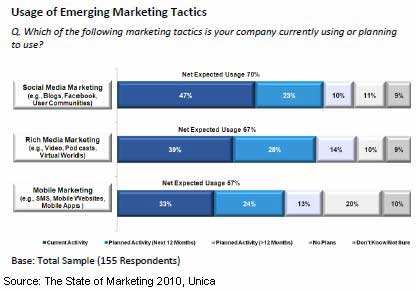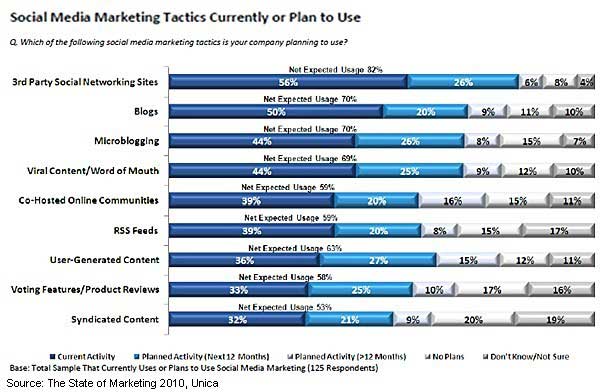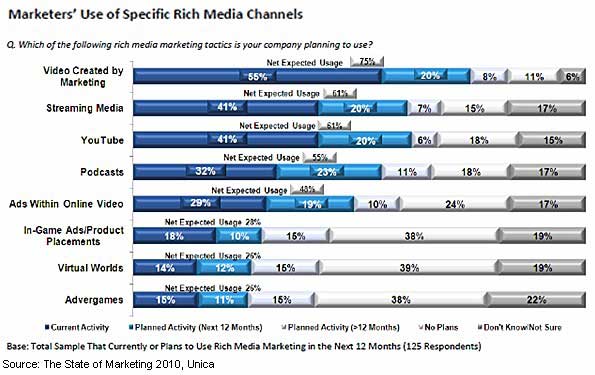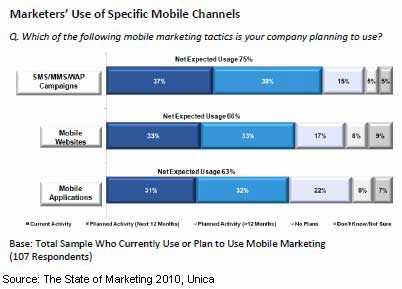Unprecedented change brought on by a volatile economy and the rise of new marketing channels is creating opportunities for marketers—and leading the way for widespread adoption of emerging tactics such as social media, rich media, and mobile marketing, according to a survey of online and direct marketers by Unica and Salloway & Associates.
Over eight in ten marketers (84%) use or plan to use at least one emerging marketing tactic (social media, rich media, or mobile marketing) in the next year.
Among marketers, 47% now use social media for marketing, and 23% plan to use it in the next 12 months.

Over one-third (39%) of marketers use rich media marketing, and 28% have plans to adopt it in the next 12 months, while 33% of marketers use mobile channels for marketing, and 24% plan to use them in the next 12 months.
Below, other findings from The State of Marketing 2010 Survey.
Social Media Marketing
More marketers in North America (58%) than in Europe (34%) use social media marketing. However, Europeans are expected to catch up this year as their pace of adoption increases relative to that of North America: 30% of European marketers plan to implement social media marketing in the next 12 months, compared with 18% of North American marketers.
Social networking sites such as Facebook and MySpace, along with blogs are mainstays in the social marketing mix: 56% of marketers who use social media use social networking sites, and 50% use blogs.

Though marketers rely heavily on more mature social platforms, nearly one-half (44%) are using microblogging sites like Twitter, and over one-quarter (26%) plan to use such sites in the next 12 months.
Emerging channels are often poorly integrated with current efforts, yet more marketers say they are trying to integrate social media tactics with other campaigns, according to Unica.
Among marketers who use social media, the most widely integrated tactics include the following:
- Voting features/product reviews: 70%
- User-generated content: 56%
- RSS feed: 54%.
- Viral content/word-of-mouth: 46%
Blogs are among the least integrated social media tactics: 39% of blogs are published in conjunction with other campaigns, while 38% run discretely.
Looking for real-world examples of businesses achieving their social media marketing goals? Our 47-page case-study collection, Facebook Success Stories, shows you how to increase brand awareness, target specific markets, promote new products, and create communities that engage users. Also check out The State of Social Media Marketing, a 240-page original research report from MarketingProfs.
Rich-Media Investments
Among marketers who use rich media, 55% use video, 41% use streaming media, use YouTube, and 23% use podcasts.

Among the top 5 rich-media tactics used, the pace of adoption is expected to increase an average of 20% in the next 12 months.
Mobile Marketing Channels
Mobile marketing continues to gain adoption, but at slightly higher rates in Europe than in North America, 37% and 29%, respectively.
Among marketers who use mobile channels, adoption is relatively even across various tactics—despite SMS's relatively broader reach:

Over one-third (37%) of marketers who have embraced mobile channels use SMS/MMS/WAP (short message service/ multimedia messaging service/ wireless application protocol) campaigns, followed by mobile websites (33%), and mobile applications (31%).
The rate of adoption across mobile marketing channels is expected to increase an average of 33% in the next 12 months.
Customer-Initiated Interaction
Marketers are leveraging customer-driven interaction: 73% say they use targeted messages in at least one inbound channel.
There is more use of inbound marketing in call centers and on websites than in physical stores. Among the most active channels, the net expected use—current activity and planned activity (in the next 12 months)—is the following:
- Customer service/call center: 71%
- Websites: 73%
- Physical store/ branches: 51%
Other survey findings:
- 25% of marketers surveyed use centralized decisioning technology to coordinate outbound and inbound marketing; 23% plan to adopt it in the next 12 months.
- 75% of marketers use or plan to use data collected from their website to help make decisions about marketing offers.
- Email (74%) is the top channel in which both online and offline data are most likely to be used in decision making (it ties direct mail for offline use), followed by direct-mail offers (58%).
- The top barrier cited for the lack of integration between online and offline data is the lack of budget resources (75%), followed by disparate systems (69%), and uncertain ROI (68%).
- The lack of IT support for marketing's technology needs (67%) is cited as the top bottleneck for business, followed by integrating cross-channel efforts (62%), and measurement, analysis & learning (58%).
About the data: The State of Marketing 2010 was conducted by Salloway & Associates on behalf of Unica during the fourth quarter 2009. The sample included over 150 online and direct marketers across a wide range of industries, geographies, and company sizes.



